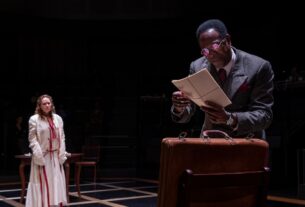(New York Jewish Week) — The table at the center of the room, set for 16, was festooned with a rainbow tablecloth and sparkles, and surrounded by about a dozen college-age guests. At its head were two chairs decorated with rainbow necklaces and flags and set for the guests of honor: Both place settings came with a headband with the word “bride” written across the top.
The group had come together last week for a sheva brachot, a Jewish celebration in which loved ones and community members gather in the week following a wedding to bless the newlyweds over a festive meal. The celebrations are common among observant couples.
But for many of the celebrants, even those who had attended other such festive meals, the dinner was still a milestone: It was their first time attending a sheva brachot for an LGBTQ couple, Rachael Fried and Henna Warman, who were married on Sept. 3.
The dinner was hosted by Jewish Queer Youth, and for one of the brides, Rachael Fried, it was more than just a celebration of her marriage. It was also a step forward for the cause she champions: supporting Orthodox LGBTQ youth and showing them that they, too, can live full lives despite Orthodox Judaism’s traditional rejection of LGBTQ relationships.
The festive dinner was part of JQY’s “Share your simcha” initiative, meant to show young Orthodox LGBTQ teens what their futures can look like. (Abbie Sophia)
While some Orthodox communities have tried to make space for LGBTQ members, the vast majority of Orthodox rabbis, citing prohibitions in traditional Jewish law, do not conduct LGBTQ weddings. Orthodox LGBTQ Jews have said they feel marginalized and discriminated against in the communities where they grew up, and recent manifestations of that discrimination have catalyzed JQY’s work.
“Queer youth from Orthodox homes don’t really get to celebrate or see a lot of communal happiness or shared queer joy today,” Fried, 36, who is JQY’s executive director, told the New York Jewish Week. “It can also be really hard for a lot of JQYers to envision a future for themselves.”
JQY serves Orthodox youth ages 13 to 23, and the celebration was part of a larger initiative the group is launching called “Share your simcha,” a Hebrew term connoting a lifecycle celebration. The initiative invites queer Jews celebrating various life events to share their experiences with JQY members so that the young people can see a world in which they, too, can celebrate traditional Jewish milestones and other joyous moments.
“When you hear about queer life experiences, you usually hear lots of negative ones — you don’t really hear about the positive ones,” said Shlomo Satt, who attended the sheva bracha with his fiancé, Mattan Rozenek. “There’s certainly no frame of reference for queer joy or queer simchas. How many gay weddings as a teenager did I see? Zero. We’ve never been to a gay wedding and we’re getting married.”
Satt, who grew up in a Haredi community in Far Rockaway, Queens, said that he chose to join JQY for a sheva brachot by “putting myself in the perspective of the young queer person.”
“It would have meant the world to me to realize I don’t have to sacrifice anything. I can have a life. I don’t need to lose anything,” he said.
JQY’s entire membership was invited to Thursday night’s celebration, which took place in Times Square at the JQY “Drop-In Center,” a space where members can meet with social workers and psychologists, eat snacks, participate in support groups and hang out with fellow queer Jews.
The meal carried many of the hallmarks of a standard sheva brachot, and a few differences. It took place five days after the wedding and guests ate a sumptuous dinner of baked ziti, sushi, salad and cupcakes.
Support the New York Jewish Week
Our nonprofit newsroom depends on readers like you. Make a donation now to support independent Jewish journalism in New York.
But instead of the seven blessings traditionally recited at the end of the meal — a repetition of the blessings said under the chuppah — guests went around the room offering personalized blessings for the couple’s marriage and future.
Amid those blessings, one JQY member shared a memory of when Fried helped them navigate a stalled subway after a JQY meeting late one evening. They wished upon Fried and Warman that “even when taking unexpected paths, they will always find their way back home.”
Others wished the couple “a lifetime of happiness” and to “appreciate the mundaneness and the quiet moments of living every day with your soulmate.”

Fried, left, and Warman, right, met online during the pandemic; they were married in Connecticut on Sept. 3. (Abbie Sophia)
Fried and Warman, a 32-year-old psychiatric nurse practitioner, also offered to answer any questions about the logistics — and emotions — involved in planning and executing a queer Jewish wedding.
The two met on the Jewish dating app JSwipe at the beginning of the pandemic. Both grew up in traditional Orthodox communities — Fried in Fairfield, CT and Warman in the Brooklyn neighborhood of Flatbush.
One attendee asked them why they decided to switch the words of one of the seven blessings from “chosson v’kallah” — bride and groom — to “Rachel v’Henna,” their names. They said it was a friend’s idea and that it made the blessings feel more natural and personal.
Another asked what the biggest surprise of the wedding was, and a third what they felt most unprepared for.
“The biggest surprise was that, for all the stress of worrying about who would come and who wouldn’t come from my family, it didn’t end up mattering at all once the wedding was happening,” Warman said. “It was just such a happy day, I really couldn’t notice or care.”
And when it came to what they were least prepared for, the answer could have come from any newlywed: “Keeping up the stamina of dancing the whole night,” Fried said.
Those answers could be of use to Satt and Rozenek, the engaged couple at the dinner, who said they hope to host a sheva brachot with JQY when they get married next month. Rozenek said he wished he had been able to meet queer, observant couples earlier in life — not just so he could see his identity reflected, but for help answering the kinds of questions asked by attendees at last week’s event.
“It’s like networking, so to speak,” Rozenek said. “Once you know somebody [queer] who is getting married, you can say to yourself, ‘If and when I have a wedding, I know where I can turn to.’ We want to continue that train and help people realize: you are not the first person to ever do this,” he said.
The “Share your simcha” initiative was something Fried and other JQY staff had been formulating in recent years as a way to “bring Jewish queer joy to our community,” Fried said. She added, “The tagline for this initiative is to ‘celebrate Jewish queer joy today and picture a queer Jewish tomorrow.’ That is exactly what we’re trying to do.”
Support the New York Jewish Week
Our nonprofit newsroom depends on readers like you. Make a donation now to support independent Jewish journalism in New York.
JQY decided to expedite the program in June, when the wedding of two Orthodox women went viral in Orthodox Whatsapp groups and on Twitter, where users lambasted the ceremony. In light of that, JQY wanted to show their support and joy for the couple, who had been members of the organization in the past, Fried said.
The launch of the initiative also follows what has been a busy year for the organization, which has been involved in an ongoing legal battle against Yeshiva University, the Modern Orthodox flagship, over its refusal to recognize an LGBTQ student group. After a judge ruled that the university must recognize the club, called the YU Pride Alliance, the university temporarily suspended all student clubs at the beginning of the 2022-2023 school year. JQY responded by offering funding and event space to any student club affected by that decision. (The Pride Alliance later put its demands on hold pending the legal appeals process, and the school’s student groups were reinstated.)
Fried and Warman’s celebration was the fourth hosted by JQY since June as part of the “simcha” initiative. There have also been two other weddings, as well as an upsherin, a ceremony held at a boy’s third birthday in which his hair is cut for the first time. The boy’s two mothers were previously members of JQY.
In addition to being a way to showcase queer joy for younger Jews, Fried and Warman said it was a treat to be celebrated by a community that can relate to their identities.
“As much as this is for the youth, it’s also for the people who are celebrating,” Fried said. “I don’t really get to have a celebration where it is just the queer community celebrating my simcha, so it’s cool to have this queer space for this queer simcha.”




